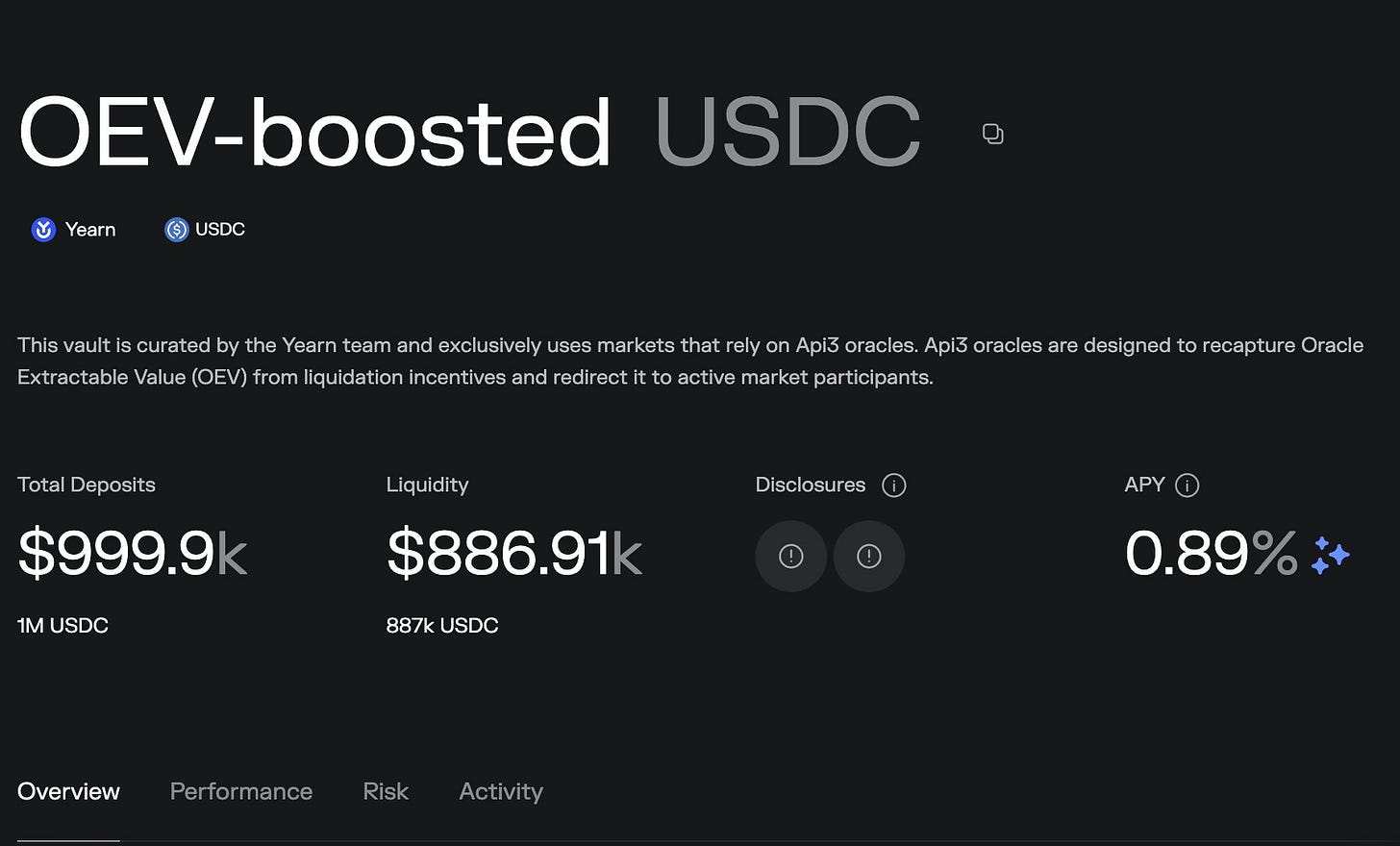The protocol layer is monetizing + Reddit will scan your eyeballs
When Perp yield gets tokenized, MEV reroutes to users, and LPs go non-directional, infrastructure is winning. Here's how!
GM Squids. You can feel the shift.
This week brought hard pivots from “degen flows” to protocol-level monetization. hwHLP turns liquidity into a structured yield product. Yearn and Api3 redirect MEV. Reddit wants biometrics to verify users. Coinbase pushes for tokenized equities in the US. Curve is quietly rewriting LP math around impermanent liquidity..
And Kraken? They just put their HQ in a state issuing its own stablecoin. This is how infrastructure wins.
Hyperwave Launches hwHLP: A Liquid, Fee-Free Entry Into Core Exchange Revenue
Hyperwave just launched hwHLP. hwHLP is the first liquid token that gives users exposure to trading fees, market-making spreads, and liquidations on Hypercore. You deposit $USDT0 or $USDe and receive hwHLP, which stays liquid and composable across DeFi.
For the first 90 days, fees are waived. The Curve tri-pool with $USDhL and $USDXL is already live. And integrations with Hypurrfi, Felix, and Kittenswap mean you can stake, lend, and loop it, making hwHLP the first natively composable perp revenue token.
This matters because hwHLP is a structured access point to one of the fastest-growing perp exchanges. Unlike GMX or Drift, where tokens accrue value abstractly, hwHLP maps directly to vault performance without inflation or emissions. An actionable pay here is to track HLP vault TVL. If flows stabilise post-launch and volumes on Hypercore remain elevated, hwHLP could serve as a new liquidity base in DeFi ecosystems. Monitor Hypurrfi strategies for yield boosts.
Yearn Captures Liquidation Profits with Api3 OEV Vaults
Yearn’s new vaults lend only to markets using Api3’s oracles, and those oracles now direct liquidation-triggered Oracle Extractable Value (OEV) back to vault participants. Instead of rewarding MEV searchers or block builders, users claim the alpha.
This works because Api3 auctions oracle updates to the highest bidder. These updates are what trigger liquidations, so the right to publish becomes valuable. And Yearn has built a system that reroutes this value to its depositors. This is even more important, as vaults are no longer passive as they used to be. By reclaiming oracle margins, Yearn introduces a native revenue source that isn’t based on emissions or token bribes. In effect, this creates “dividend-generating” vaults which is the first of their kind.
An actionable play here will be to watch Merkl dashboards for OEV flows in gas tokens or USDC. Compare the yield efficiency of these vaults vs traditional Aave/Morpho lending. If adoption scales, expect copycat integrations with other oracles like Redstone or Pyth.
Reddit May Use World ID to Verify Humans
Reddit is in talks with Tools for Humanity to integrate World ID, the iris-scan-based verification system behind Worldcoin. The move comes as Reddit prepares for incoming AI-generated content, spam bots, and age verification mandates, all while trying to preserve anonymity.
World ID works by scanning a user’s iris with a physical Orb device to generate a zero-knowledge proof of uniqueness. The encrypted biometric is then sharded and stored across multiple secure servers. Reddit would not receive any personal data, only confirmation that the user is a real, unique human.
In theory, it addresses the platform’s biggest challenge in the AI era: keeping bots out while preserving anonymity. With 430 M+ users, Reddit could become the first mainstream social platform to experiment with decentralised proof-of-personhood.
If adopted, Reddit would likely offer users multiple verification options. World ID would serve as one opt-in method, enabling users to prove humanness or age without logging personal information. Users could verify directly through the World App, or possibly with a device-signed credential stored locally on their phones. A non-Orb version of World ID (via scanned documents) may be supported, but with reduced platform privileges.
Early adoption could catalyze broader use of World ID in consumer-facing apps. Expect growth in tooling for zk-attestations, zero-knowledge login layers, and passport-style identity overlays such as Gitcoin. This would mark the first real test case of decentralized identity at Web2 scale.
Curve Debuts Yield Basis to Eliminate Impermanent Loss
Michael Egorov just introduced Yield Basis which is a leveraged LP design that minimizes impermanent loss by realigning exposure with the direction of the underlying assets. Instead of passively providing equal parts of both tokens in a pool, LPs deposit one asset (e.g., ETH), and the system borrows the counter-asset (e.g., USDC) to simulate a full liquidity position. This creates a leveraged structure that maintains directional exposure.
This invites passive capital that has sat out of DeFi due to IL risks. It’s Egorov’s quiet revenge to re-monetize DeFi flow at the protocol layer. For example, if a user deposits $10,000 in ETH when ETH is priced at $2,000, the system borrows $10,000 in USDC and provides $20,000 total to the ETH-USDC pool. The LP effectively holds a 2x long ETH position within the AMM, while also collecting fees from swaps.
If ETH rises 20% to $2,400, the LP’s position increases in value accordingly, unlike in a traditional 50/50 pool, where the LP would lose ETH exposure due to rebalancing and suffer impermanent loss. This setup means the LP benefits from both price appreciation and yield without sacrificing principal to IL. If swap fees generate 8% annually and ETH rises 20%, the LP sees total gains close to 28% compared to ~18% in a typical AMM with impermanent loss.
With this new structure, liquidity providers behave more like traders with yield. The system dynamically reallocates positions so that price movement doesn’t hurt LPs. This removes one of DeFi’s longest-standing pain points. The move here will be to track initial vault sizes and slippage stats. If LPs gain vs hodlers in volatile markets, expect copycats in Meta AMMs. Also, watch for Basis integration with Curve’s L2 stacks (e.g., Conic or LLAMMA strategies).
Here’s a more detailed breakdown of how it all works:
Kraken Moves HQ to Wyoming — Why It’s More Than a PR Stunt
Kraken has formally re-registered in Cheyenne, Wyoming, aligning itself with the only U.S. state actively building a crypto-native legal framework. Wyoming already offers a regulatory sandbox, full property rights for private keys, and is preparing to issue a state-backed stablecoin called the Wyoming Stable Token (WST).
Kraken holds a Special Purpose Depository Institution (SPDI) charter, which was granted in 2020. This lets it offer custody and payment services without relying on fractional reserves — basically a crypto-native banking license.
With no federal crypto law in place, Wyoming’s lead is widening. If WST gains merchant adoption, even locally, the state could become the first true onchain monetary zone in the U.S. Watch Custodia Bank as a parallel test case. It’s running on the same license, with similar ambitions.
Coinbase Petitions SEC for Tokenized Equities
Coinbase is seeking a no-action letter from the U.S. SEC that would let it offer tokenized equities to American users. These would be blockchain-based tokens that represent ownership in companies like Apple or Tesla, tradable directly on Coinbase.
The exchange already acquired a broker-dealer license in 2018 but hasn’t used it. With this SEC letter, Coinbase wouldn’t need full re-registration, just explicit permission to move forward without facing enforcement. If granted, this would be the first regulatory green light for onchain equities in the U.S.
Kraken has already launched tokenized U.S. equities abroad via xStocks. If Coinbase succeeds in getting U.S. approval, it would immediately leapfrog into direct competition with Robinhood and Schwab with deeper tech rails and wider protocol integration.
This can be seen as a pivotal regulatory test. If the SEC grants the letter, expect a surge of capital and dev activity into tokenization protocols like Polymesh, Securitize, Figures Markets, and Ondo Finance.
Project Updates
Iranian crypto exchange Nobitex hacked for $80M, attacker sends funds to burn addresses with the phrase “Fuck RGCT”.
Fileverse just shipped dSheets, a decentralized spreadsheet app with onchain data access and wallet-based access control. Think Notion x Google Sheets, but for DAO ops.
Sandeep Nailwal, one of Polygon’s co-founders, is launching ZisK, a new zero-knowledge project independent from Polygon Labs. It aims to tackle generalized ZK computation with a leaner, research-first structure.
Builder infra firm Delv is calling it quits. Despite multiple integrations and an early lead in protocol tooling, the team said the market environment and internal alignment weren’t enough to keep going.
CowSwap just unveiled FCBAs (Fully Customizable Batch Auctions), a new primitive for MEV protection and order batching that can accommodate a wide range of execution strategies.
That’s your weekly intelligence drop, Squids 🦑
Less hype, more signals. Leviathan will be watching how these plays develop across chains and state. If it compounds, we’ll cover it.







